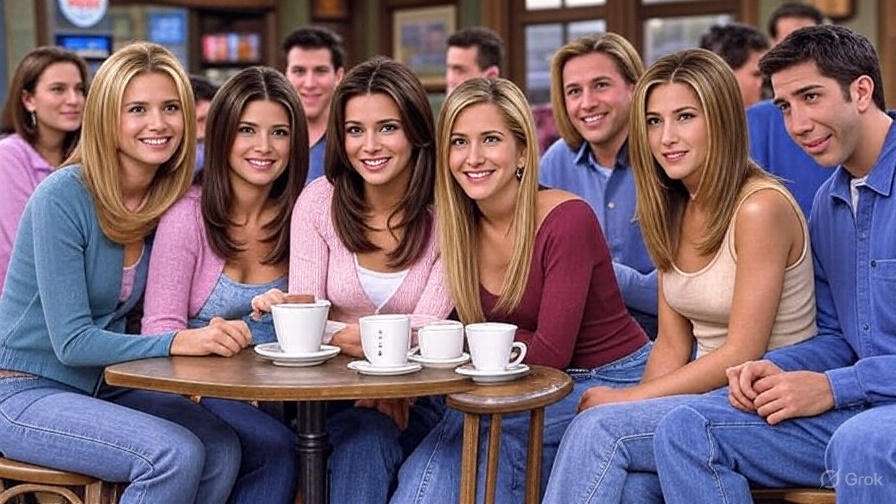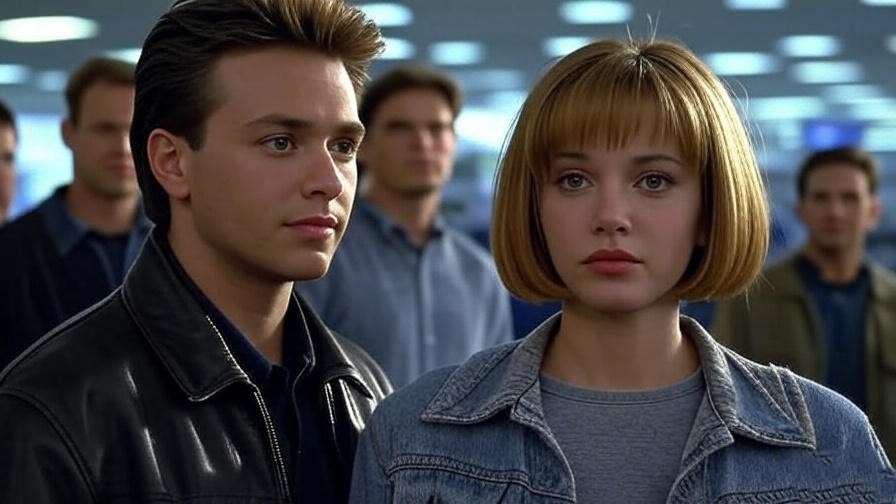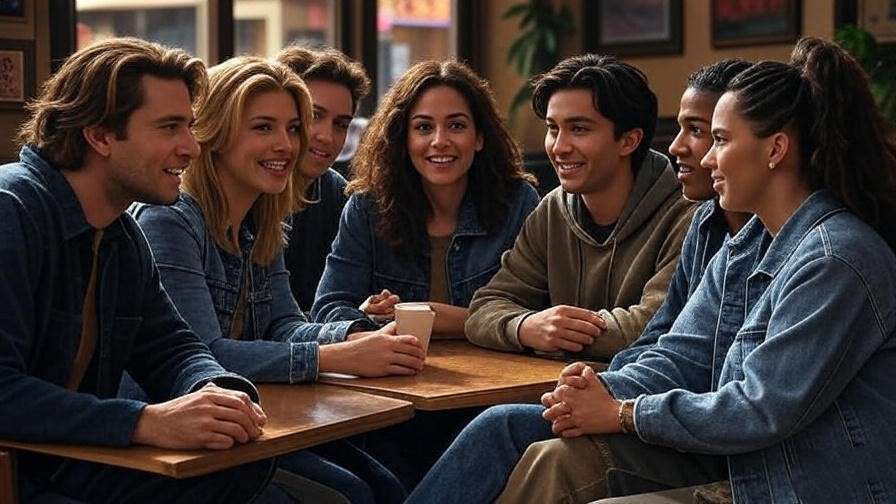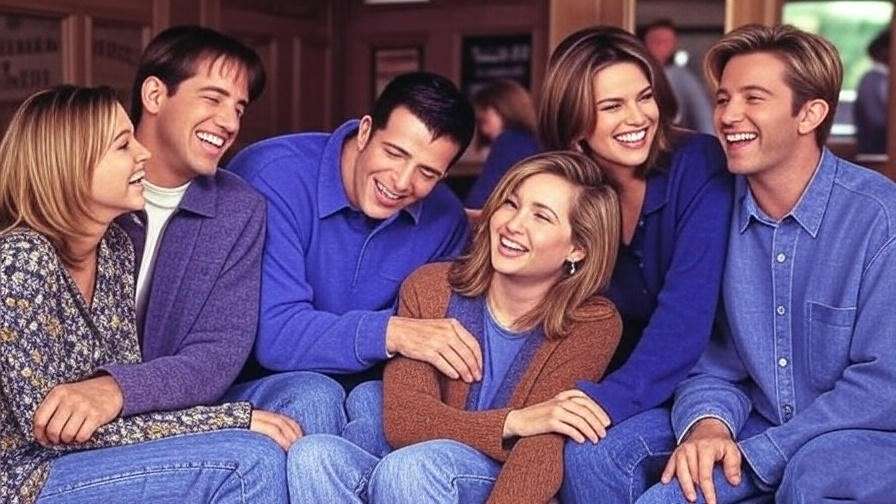Picture this: It’s a cozy Friday night, and you’re curled up on the couch, streaming Friends for the umpteenth time. Ross yells, “Pivot!” as he wrestles a couch up a staircase, and you can’t help but laugh. Or maybe you’re a new viewer, puzzled by Chandler’s sarcastic “Could I be more…” quips or Phoebe’s bizarre “Smelly Cat” song. If these moments spark joy or curiosity, this Friends glossary is your ultimate guide to decoding the iconic terms, catchphrases, and cultural references that make Friends a timeless TV classic. As a lifelong fan who’s rewatched every episode, analyzed fan forums, and even visited a Central Perk pop-up, I’ve crafted this comprehensive glossary to enhance your Friends experience—whether you’re a newbie or a die-hard fan. Let’s dive into the lingo that’s kept Friends in our hearts for over 30 years.
Why Friends Lingo Still Resonates Today
The Cultural Impact of Friends
Friends didn’t just dominate TV screens from 1994 to 2004; it reshaped pop culture. With over 52 million viewers for its finale and a continued streaming boom on platforms like Max, the show’s dialogue has seeped into everyday language. Phrases like “How you doin’?” and “pivot” have transcended the screen, appearing in memes, merchandise, and even casual conversations. According to a 2023 study by Parrot Analytics, Friends remains one of the most-watched shows on streaming platforms, proving its staying power. This glossary unpacks why these terms resonate, connecting fans across generations.
Who Needs a Friends Glossary?
Whether you’re binge-watching Friends for the first time on Netflix or revisiting episodes to relive ‘90s nostalgia, this glossary is for you. New viewers might miss the context of dated references like Ross’s “unagi” mix-up, while longtime fans may want to dive deeper into trivia, like the origins of Janice’s “Oh. My. God.” Trivia buffs and fan communities on Reddit’s r/friends_tv will find this guide perfect for mastering Friends lingo for quizzes or debates. This glossary solves the problem of understanding the show’s humor and cultural context, making every episode more enjoyable.
The Essential Friends Glossary: Iconic Terms and Phrases
Catchphrases That Defined the Show
Joey’s “How You Doin’?”
Definition: Joey Tribbiani’s smooth-talking pickup line, first heard in Season 4, Episode 13 (“The One with Rachel’s Crush”).
Context: Joey (Matt LeBlanc) uses this line to charm women, often with comical results. It’s become a cultural phenomenon, plastered on T-shirts and quoted in countless memes.
Fun Fact: LeBlanc revealed in a 2021 Friends reunion special that he improvised the line’s exaggerated delivery, making it an instant hit.
Example: Fans might jokingly use “How you doin’?” at a Friends-themed trivia night to channel Joey’s charm.
Ross’s “We Were on a Break!”
Definition: Ross Geller’s infamous defense during his breakup with Rachel in Season 3, Episode 15 (“The One Where Ross and Rachel Take a Break”).
Context: This line sparked one of TV’s most debated storylines, symbolizing Ross and Rachel’s on-again, off-again romance. It’s a go-to phrase for fans discussing relationship missteps.
Example: On social media, fans post “We were on a break!” memes when debating loyalty or breakups.
Tip: Rewatch Season 3 to catch the full context of this iconic argument.

Chandler’s “Could I Be More…?”
Definition: Chandler Bing’s sarcastic catchphrase, emphasizing his self-deprecating humor, first prominent in Season 1.
Context: Played by Matthew Perry, Chandler uses this line to mock situations, like “Could I be more sorry?” It highlights his wit and insecurity, endearing him to fans.
Fun Fact: Writers crafted this phrase to mirror Perry’s natural comedic timing, as noted by co-creator Marta Kauffman.
Tip: Try using this phrase playfully in conversations, like “Could I be more tired?” to channel Chandler’s vibe.
Location-Based Terms
Central Perk
Definition: The fictional Greenwich Village coffee shop where the gang spends countless hours.
Context: Central Perk is more than a setting—it’s a symbol of ’90s coffee culture and the group’s friendship. Its cozy orange couch and quirky barista Gunther made it iconic. Real-world replicas, like the Central Perk pop-up in New York, draw fans globally.
Expert Insight: Sociologists describe Central Perk as a “third place”—a community hub outside home and work—enhancing its emotional pull.
Fun Fact: The show’s set designers based Central Perk on real Manhattan coffee shops, though the exterior was filmed in LA.

Monica’s Apartment
Definition: Monica’s spacious, purple-walled apartment, the primary setting for group hangouts.
Context: Known for its meticulous organization and iconic peephole frame, it’s a fan-favorite location. Fans obsess over its unrealistic size for a Manhattan apartment.
Fun Fact: The show inconsistently numbered the apartment (originally 5, later 20), a detail eagle-eyed fans love debating.
Tip: Check out fan-made floor plans online to explore Monica’s apartment layout.
Character-Specific Slang and Quirks
Phoebe’s “Smelly Cat”
Definition: A quirky song written and performed by Phoebe Buffay at Central Perk, first in Season 2, Episode 6 (“The One with the Baby on the Bus”).
Context: This offbeat tune reflects Phoebe’s eccentric personality and became a fan anthem, even inspiring merchandise.
Example: Lyrics like “Smelly cat, smelly cat, what are they feeding you?” are sung by fans at Friends-themed events.
Fun Fact: Lisa Kudrow wrote parts of the song, showcasing her comedic talent.
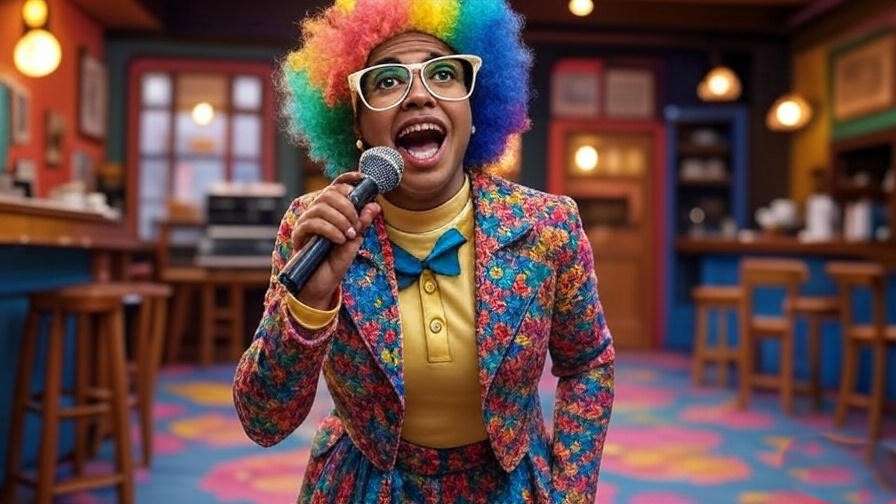
Janice’s “Oh. My. God.”
Definition: Janice Litman-Goralnik’s exaggerated exclamation, delivered in her nasal voice.
Context: Played by Maggie Wheeler, Janice uses this phrase for dramatic effect, making it one of the show’s most recognizable lines.
Fun Fact: Wheeler told Entertainment Weekly she crafted Janice’s voice to stand out, turning a small role into a fan favorite.
Example: Fans mimic “Oh. My. God.” when quoting Janice in cosplay or skits.
Cultural and Time-Specific References
Unagi
Definition: Ross’s misuse of a sushi term to mean “total awareness” in Season 6, Episode 17 (“The One with Unagi”).
Context: Ross claims “unagi” is a martial arts concept, leading to hilarious exchanges with Rachel and Phoebe. The real unagi is eel, making his mistake comedy gold.
Tip: When watching, note how Ross’s confidence in his wrongness drives the humor.
Fun Fact: Fans on X often post “Unagi!” when joking about being hyper-aware.
The Rachel
Definition: Rachel Green’s layered haircut, popularized in Seasons 1–3.
Context: This hairstyle, created by stylist Chris McMillan, became a ’90s phenomenon, with salons flooded with requests. It’s still a style icon today.
Expert Insight: Jennifer Aniston told Allure in 2015 that she wasn’t a fan of the maintenance, but fans adored it.
Example: Search “The Rachel haircut” on Pinterest for modern takes on the style.

Beyond Catchphrases: Hidden References and Easter Eggs
Recurring Jokes and Running Gags
Friends thrives on running gags that deepen character arcs. Monica’s obsession with “seven” (Season 4, Episode 11) humorously explores her intensity, while Ross’s three divorces (starting in Season 3) cement his romantic struggles. Chandler’s vague job—often mocked as “transponster” by Rachel—keeps fans guessing (it’s data processing, per Season 9). These gags reward rewatching, as they build layers of humor.
Tip: Watch “The One with the Embryos” (Season 4, Episode 12) for a masterclass in running gags, like the trivia game revealing these quirks.
Pop Culture and Guest Star Mentions
Friends wove ’90s pop culture into its dialogue, from Joey’s obsession with Baywatch to his role on Days of Our Lives. Guest stars like Bruce Willis (as Paul, Ross’s rival) added iconic lines, like his awkward “I’m just gonna go… flush myself down the toilet.” These references ground the show in its era, making a glossary essential for younger viewers.
Fun Fact: Guest stars included Julia Roberts, Robin Williams, and Brad Pitt, whose cameos sparked memorable dialogue.
How to Use This Glossary to Enhance Your Friends Experience
Tips for New Viewers
If you’re new to Friends, the show’s ’90s references and rapid-fire humor can feel like stepping into a time capsule. This Friends glossary helps you decode terms like “pivot” or “unagi,” making episodes more accessible. Start with Season 1 to grasp the group’s dynamics, but don’t miss “The One with the Embryos” (Season 4, Episode 12) for a crash course in glossary terms like Chandler’s job confusion or Monica’s “seven.”
Tip: Keep this glossary handy on your phone while streaming to catch every joke. Pause and look up terms like “Central Perk” to appreciate their cultural weight.
Engaging with the Friends Fandom
The Friends fandom thrives online, from Reddit’s r/friends_tv to X posts tagged #FriendsForever. Use this glossary to join discussions or shine at trivia nights. For example, drop “How you doin’?” in a thread about Joey’s best moments or debate “We were on a break!” in relationship posts. Fan events, like Friends-themed pub quizzes, often reward glossary knowledge.
Example: Create a TikTok skit using Janice’s “Oh. My. God.” to connect with younger fans.
Tip: Follow fan accounts on X for real-time Friends trivia and glossary term debates.

Rewatching with a Fresh Perspective
For seasoned fans, this glossary adds depth to rewatches. Spotting terms like “Smelly Cat” or “The Rachel” reveals new layers, like Phoebe’s quirky songwriting process or the haircut’s cultural impact. Try a Friends bingo game: mark off glossary terms like “pivot” or “unagi” as they appear. Rewatching “The One with All the Thanksgivings” (Season 5, Episode 8) highlights recurring gags, like Monica’s turkey dance.
Tip: Use a streaming service’s episode guide to target glossary-heavy episodes, like “The One with the Prom Video” for “The Rachel” context.
Fun Facts and Trivia to Impress Fellow Fans
Behind-the-Scenes Insights
The Friends writers, led by David Crane and Marta Kauffman, crafted catchphrases to match each actor’s strengths. For instance, Matthew Perry’s natural sarcasm inspired “Could I be more…?” as revealed in a 2021 HBO Max reunion special. Joey’s “How you doin’?” evolved from Matt LeBlanc’s ad-libbed delivery, while Lisa Kudrow’s musical background shaped “Smelly Cat.” These insights, sourced from interviews in Entertainment Weekly and Variety, showcase the show’s collaborative genius.
Fun Fact: The Central Perk set was built to feel like a real coffee shop, with working espresso machines, per set designer John Shaffner.

Friends in Pop Culture Today
Friends remains a cultural juggernaut. In 2024, Max reported 25 billion minutes of Friends streamed globally, per Nielsen data. Memes like Ross’s “pivot” couch struggle flood X, while “Smelly Cat” merchandise sells out on Etsy. The 2021 Friends: The Reunion special reignited fan passion, with stars reminiscing about glossary terms like “We were on a break!” Modern shows like Brooklyn Nine-Nine reference Friends, proving its influence.
Example: Search #Pivot on X to see fans recreating Ross’s couch scene in hilarious videos.
FAQs About Friends Terminology
What does “pivot” mean in Friends?
Ross’s desperate cry of “Pivot!” in Season 5, Episode 16 (“The One with the Cop”) comes from his struggle to move a couch up a tight staircase. It’s a comedic gem symbolizing his stubborn determination. Watch this episode for a laugh-out-loud moment.
Why is “unagi” so funny?
In Season 6, Episode 17, Ross claims “unagi” means total awareness, confusing it with a sushi term (eel). His earnestness, paired with Rachel and Phoebe’s mockery, makes it a fan-favorite misunderstanding. The real unagi is a Japanese dish, not a mindset.
What’s the deal with Chandler’s job?
Chandler’s job—data processing in statistical analysis—was a running gag because no one, including his friends, understood it. Rachel’s “transponster” guess in Season 4, Episode 12, became a fan-favorite misnomer. Rewatch “The One with the Embryos” to see this joke shine.
How did “The Rachel” haircut become so iconic?
Rachel’s layered haircut, debuted in Season 1, sparked a ’90s salon craze. Stylist Chris McMillan created the look, blending shaggy layers with volume. Jennifer Aniston told Allure it was high-maintenance, but fans still request it today. Check Pinterest for modern “Rachel” inspo.
Conclusion
This Friends glossary is your key to unlocking the humor, heart, and cultural legacy of Friends. From Joey’s “How you doin’?” to Ross’s “unagi” blunder, these terms define the show’s charm and connect fans worldwide. Whether you’re a new viewer decoding ’90s slang or a trivia buff impressing friends, this guide enhances every episode. Bookmark it, share it on X with #FriendsGlossary, or comment your favorite Friends phrase below. As a lifelong fan who’s studied every episode and joined fan discussions, I invite you to rewatch Friends with this glossary as your guide—because, as Chandler might say, “Could it be more fun?”

